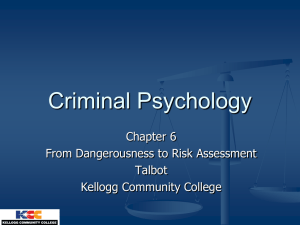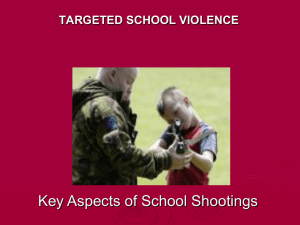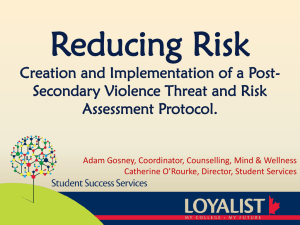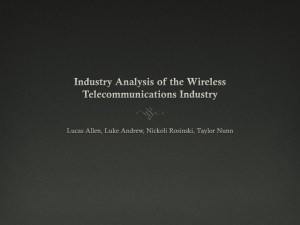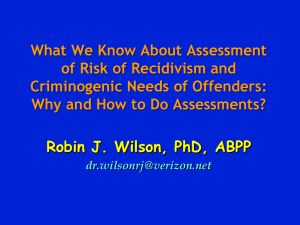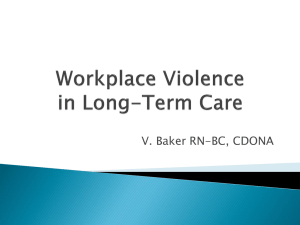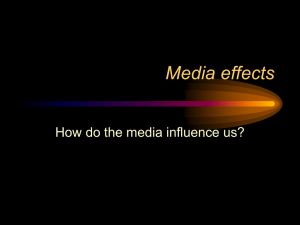Criminal Psychology - Kellogg Community College
advertisement
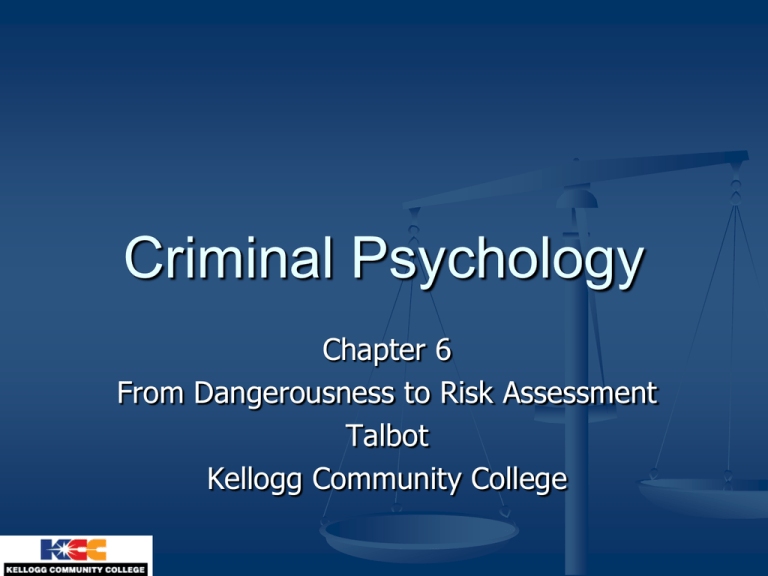
Criminal Psychology Chapter 6 From Dangerousness to Risk Assessment Talbot Kellogg Community College Risk Assessment - Dangerousness The process of conceptualizing various hazards in order to make the judgments about their likelihood and the need for various preventative measures. Three types of Predictions Clinical Prediction – prediction based on clinical experience. Actuarial Prediction – prediction is based on a statistical scheme or formula. Anamnestic Prediction – prediction is based upon how a particular person has acted in the past. Risk Assessment - Dangerousness The process of conceptualizing various hazards in order to make the judgments about their likelihood and the need for various preventative measures. Dangerousness What is it? Dangerousness as a dichotomous variable. Statistical measures and correlations. Mental illness and violence. Risk Assessment - Violence Violence – Defined? Force/ Energy Types of violence Sexual Offending? Domestic Violence Workplace Violence School Violence Risk Assessment - Violence Continuum Tools for Risk Assessment Psychopathy Checklist Revised Violence Risk Appraisal Guide Rapid Risk Assessment of Sexual Recidivism Spousal Assault Risk Assessment Guide JACA Principle Three types of predictors Static Predictors – features of an individual that are not changeable (e.g. alcohol abuse, major mental disorders). Dynamic Predictors – things that change over time and situation (e.g. psychotic symptoms, anger control, neg. emotions). Risk Management Predictors – focus on the nature of the situation or environment in which the person lives or will live (e.g. lack of supervision, lack of support, access to weapons). Risk Assessment Predict the Prediction What is it? Elements of Prediction Measurability – How measurable is the outcome? Vantage – Are you in a position to view the indicators? Context – Is the context of the situation clear to you? Imminence – How soon is the event in question? Experience – Do you have specific experience with the topic? Comparable Events – Are there any on which to base the judgment? Objectivity – Can you consider either outcome? Investment – To what degree are you vested in the outcome? Replicability – Can you pre-test the situation? Knowledge – Do you have accurate information about the issue? PINs (Pre-Incident Indicators) – Do you have access to any reliable PINS? Why do it? Makes a prediction of an individual’s future acts. Consistent with psychology’s role in a variety of settings and self proclaimed goals. How do we do it? JACA Justification Alternatives/ Options Consequences Good Bad Access Justification - 1st hurdle Does the individual have subjective justification? Or have they justified a reason that they should do the aggressive act? “I warned her what would happen and she did it anyway.” Alternatives Do they have options other than acting out aggressively? i.e. “I am calling my lawyer and will have your job” vs. “No one can help now!” The second is a much more threatening response. Consequences Does the individual identify any rewards or negative consequences to being aggressive or violent? Examples of concerning responses would include “I can do jail time.” or “I might get caught but it would feel good!” Access Does the individual have access to carrying out the threat? We typically assume access is present. Just because we don’t think they will actually build a nuclear bomb, they might Google search and find they have everything for a pipe bomb. Threat Level Determination 0 elements present – no threat 1 element present – mild threat 2 elements present – moderate threat 3 elements present – severe threat 4 elements present – profound or imminent threat. Risk Assessment Guidance Paper & Scoring Rubric For this assignment the student will review the threatening letter/ case study provided in course information. The student will then prepare a written assessment of the level of risk or threat present (mild, moderate, severe, or profound). A variety of threat assessment tools are available, however the one to be used for this assignment is the JACA principle developed by Gavin DeBecker. A full explanation can be found in his book, The Gift of Fear and is summarized in the PP presentation located in BB under course information. This assignment should be written as a letter to the administration of the company for which Laura works (ESL Electronics), and who we are assuming, provided you with this letter and the question, “Should we be worried?”. Laura is an employee who was given the provided letter from Rick, another employee. Your response should: identify and explain the tool (with proper citations) which was employed, summarize the case study or letter reviewed, describe the JACA principle (in understandable and general terms) identify how various parts of the letter fit or do not fit the JACA principles and specifically which ones, and determine the current level of threat present (in your opinion). Back this determination up with information from the letter/ case study and risk assessment used. A description of “Risk Assessment” and it benefits and limitations should also be included. 2 – 4 pages Scoring Rubric Appropriate choice and use of Assessment Tool – 25 pts Appropriate Discussion/ Description of the Assessment Tool – 25 pts Description of Risk Assessment (benefits & limitations) – 25 pts Clear and concise reporting of final assessed risk – 25 pts Case Study Intuition What if you don’t have the information to perform a standardized risk assessment? Fear standard – Intuition DeBecker recommends one “follow their gut feeling when other information is not available.” Gift of Fear Why is it not used? Why and when might it be encouraged? Februrary 16th, 1988 "... The shit has hit the fan... all because you thought I'm a joke and refuse to listen or understand that I am gravely serious." 18 months after the writing of the letter, Rick Farley entered ESL armed, shooting 11 (including Ms. Black) and killing 7. This was the day prior to the date he was to appear in court for a restraining order filed by Laura Black. Before he surrendered, Lieutenant Grijalva said, Mr. Farley had expressed remorse about the shootings and said: ''I'm not crazy - I know I will
